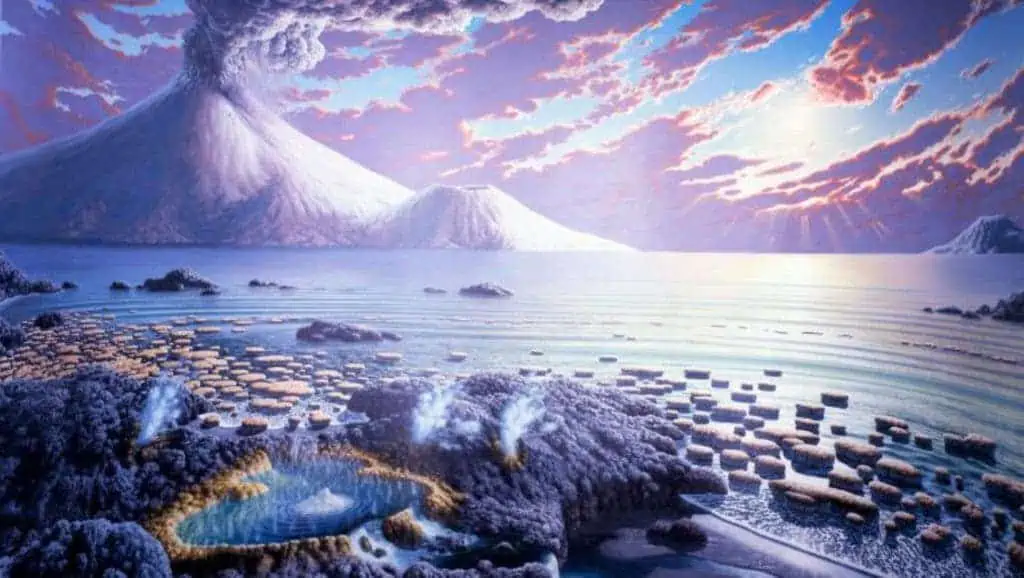
Researchers at Purdue University have just demonstrated a mechanism by which the basic building blocks for life can form in water, inching us a step closer to finding the chemical formula that gave rise to life on Earth. This major discovery hinges on the fact that water droplets are actually ‘dry’ on their margins, enabling much faster chemical reactions that can lead to the formation of proteins from amino acids.
Water life
The oldest direct evidence of life is cyanobacteria from Archaean 3.5-billion-year-old rocks found in western Australia. These were a primitive but nevertheless diverse group of organisms, including phototrophic bacteria that would have relied on the sun to produce energy, archaea that produced methane, and gammaproteobacteria that consumed methane, a gas that was abundant in Earth’s early atmosphere before oxygen was present.
By all standards, these were already pretty complex lifeforms so their story must have begun substantially earlier. Nobody knows how early exactly, but scientists are beginning to understand how life appeared in the first place.
There is evidence suggesting that Earth harbored liquid water oceans as early as 4.3 billion years ago, just 250 million years after the planet formed and nearly 800 million years before the first microfossils bearing traces of bacteria.
But although liquid water is essential to life, too much water paradoxically doesn’t allow raw amino acids to react and link up into peptides, essential ingredients for all life on Earth. Peptides form the fabric of proteins, which serve as catalysts for biological processes, but the process that leads to their formation requires the loss of a water molecule. That’s mighty hard to do in an ocean world.
Life nevertheless surfaced in a huge primordial soup, so there must be a puzzle piece that scientists have been missing. The blanks in our understanding have now been filled by researchers at Purdue led by Professor Graham Cooks, an expert in mass spectrometry and early Earth chemistry.
Water isn’t wet everywhere
More than a decade ago, Cooks and colleagues noticed that chemical reactions happened up to a million times faster in microdroplets of water. Naturally, this immediately piqued everyone’s attention, especially since this could have important implications for hypotheses conducive to the formation of the first life on Earth.
As we examined more chemical reactions we started to connect fast reactions in microdroplets with an interest of ours (and many other scientists) in the chemistry that led to life,” Cooks told ZME Science.
Thermodynamics says that reactions in which water is lost should not occur in water. But all evidence points to the chemistry that led to living systems occurring in the primitive ocean. This presents a conundrum that has received much attention in the scientific literature for more than a decade. Our main finding is that reaction with loss of water occurs in water microdroplets, so we conclude that water droplets are not wet everywhere! In particular, the surfaces must be dry to allow amino acids to lose water and click together to form peptides and so on with further loss of water to give proteins.”
Experiments performed by the researchers revealed that, on the margins, where the ocean’s surface meets the atmosphere, the surfaces of microdroplets are actually dry, meaning they terminate in protons, “which would love to grab water and be stabilized,” Cooks said.
This process wasn’t immediately obvious, though, and it took the researchers more than a year to unravel a particularly thorny challenge during their research.
“We were excited to do the microdroplet experiment with amino acids (alanine) and see an ion in the mass spectrometer that corresponded to the dialanine (two alanines minus water). Its exact mass was right. Its fragmentation pattern seemed ok, but when we measured its cross section (by a method called ion mobility spectrometry) it differed from that of authentic dialanine. For a year we struggled to find out what it was. Now we know but we also know that it interconverts with authentic dialanine and forms trialanine when treated with more alanine. So this was a complication but the simple fact is that spraying microdroplets of amino acids gives peptides as well as these isomers,” Cooks said.
In early Earth, billions of years ago, this phenomenon allowed places such as where ocean water meets the shore or where freshwater flows down a slope to essentially become fertile breeding grounds for the first lifeforms. Amino acids rained down by meteorites would have dissolved in bulk water, where they didn’t actually react — but at the surface of microdroplets that’s another story. “As we show, microdroplets of water sprayed together to react and give di- tri- etc. up to six-amino acid units in a peptide (very small protein),” Cooks said.
Since the rate of reaction at the surface of water microdroplets is so high, this dispenses with the need for catalysts, thereby making the evolution of life in a prebiotic environment possible. Once the biopolymers are generated, which eventually give rise to basic genetic units such as RNA, self-replication is automated.
Such research is essential to understanding where, how, and why life appeared, both here on Earth but also potentially elsewhere on other planets. Additionally, the same water chemistry could also inform scientists about how to speed up some practically useful reactions that are necessary for developing new drugs and treatments.
The findings appeared in the journal Proceedings of the National Academy of Sciences.


